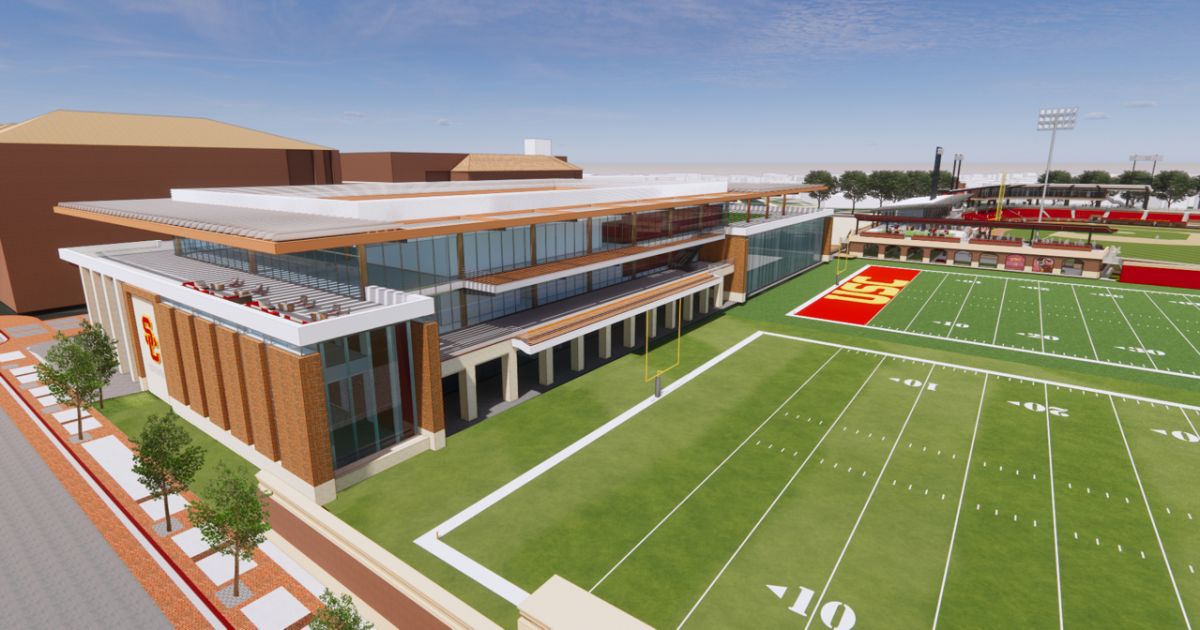Lincoln Riley calls USC facility upgrade plans a game changer
A conceptual artist sketch of the planned USC football performance center. The rendering is subject to change during the construction process.
After a year spent rebuilding its football program, with a new coach and a new culture, USC is turning its attention to rebuilding facilities.
USC announced on Thursday long-awaited plans to build a three-level, football-only performance center that includes a second, full-length practice field alongside its current practice field, a new locker room, new weight and training rooms, multiple player lounges and a rooftop hospitality deck, among other amenities meant to garner the attention of recruits and set USC apart from other blue blood programs.
How much that project might cost or when it might be finished was unclear as of Thursday. But with a leap to the Big Ten looming, USC’s leaders have made it clear they have big plans for the future of the school’s athletic facilities.
It was only 11 years ago that USC unveiled the John McKay Center, a $70-million, 110,000 square-foot facility on campus that it described at the time as “state-of-the-art.” But the quality of USC’s football facilities were quickly eclipsed in the years that followed as the facilities arms race across college football boomed. While other top programs boasted gleaming, luxury amenities for their football teams, USC still shared its weight room with other teams at the school. Its offices for staff members were cramped.
USC’s lacking football facilities were one of the major question marks facing the program — and a sore subject for frustrated fans — when Lincoln Riley took the reins as coach in November 2021. Eighteen months later, in a statement announcing the new performance center, the coach called the facility “an absolute game-changer.”
Advertisement
“Even before I took this job, I outlined things that I thought were gonna be really, really key to this place being successful,” Riley said in January.
It was no secret that new facilities were high on that list. Just 18 months into his tenure, plans are already set for a performance center that Riley calls “an absolute game-changer”.
“It will be the perfect home for our team,” Riley said.
The new football center was just one part of a major facilities plan laid out last week to USC’s board of trustees by university President Carol Folt, who has recently labeled athletics improvements as one of her “moonshot” priorities for the university’s future. That vision also includes a new, $38-million home for women’s soccer and lacrosse, Rawlinson Stadium, to replace its current home, Soni McAlister Field, as well as an upgraded — and slightly repositioned — version of Dedeaux Field, USC’s baseball stadium.
A new, upgraded baseball stadium was already a part of the city’s plans for the 2028 Summer Olympics, when it will host the swimming and diving portions of the Games. The looming question was where a baseball stadium might fit on an already densely packed campus — and how that might also affect plans for a new football stadium.
USC managed to find room enough to fit two practice football fields, where prospective recruits will be able to observe practice from the performance center’s rooftop hospitality lounge. Inside, USC will have office space to house burgeoning support staff, with areas specifically designed for recruiting.
An artist’s sketch of the proposed new football performance center and baseball stadium show that the new Dedeaux Field will be moved back toward Vermont Avenue, an area currently occupied by tennis courts and a facilities building.
A conceptual artist sketch of the planned USC football performance center. The rendering is subject to change during the construction process. (USC)
USC teased other potential plans to “transform” its athletics facilities in its announcement, including “future renovations to the John McKay Center for all student athletes, a significantly expanded student athlete dining facility, an upgraded golf practice facility and enhancements to the Galen Center.”
It’s an ambitious — and probably expensive — plan. But one that USC and its president have put their full support behind, as the Big Ten awaits next summer.
“We want to provide the facilities and support for those dreams to come true,” Folt said. “These exciting new plans will benefit Trojan athletes across all 21 programs.”
Source: Los Angeles Times


